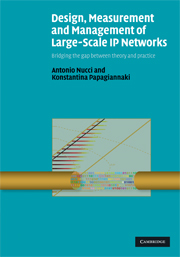 Design, Measurement and Management of Large-Scale IP Networks
Design, Measurement and Management of Large-Scale IP Networks from III - From bits to services
Published online by Cambridge University Press: 05 September 2012
As already presented, the Internet routing system is partitioned into tens of thousands of independently administered Autonomous Systems (ASs). The Border Gateway Protocol (BGP) is the de facto inter-domain routing protocol that maintains and exchanges routing information between ASs. However, the BGP was designed based on the implicit trust between all participants and does not employ any measure to authenticate the routes injected into or propagated through the system. Therefore, virtually any AS can announce any route into the routing system, and sometimes the bogus routes can trigger large-scale anomalies in the Internet. A canonical example occurred on April 25, 1997, when a misconfigured router maintained by a small service provider (AS7007) in Virginia, USA, injected incorrect routing information into the global Internet and claimed to have optimal connectivity to all Internet destinations. As a result, most Internet traffic was routed to this small ISP. The traffic overwhelmed the misconfigured and intermediate routers, and effectively crippled the Internet for almost two hours. Since then, many such events have been reported, some of them due to human mistakes, others due to malicious activities that exploited vulnerabilities in the BGP in order to cause large-scale damage. For example, it is common for spammers to announce an arbitrary prefix and then use that prefix to send spam from the hijacked address space, making the trace back and the spammer identity discovery much more difficult.
To save this book to your Kindle, first ensure [email protected] is added to your Approved Personal Document E-mail List under your Personal Document Settings on the Manage Your Content and Devices page of your Amazon account. Then enter the ‘name’ part of your Kindle email address below. Find out more about saving to your Kindle.
Note you can select to save to either the @free.kindle.com or @kindle.com variations. ‘@free.kindle.com’ emails are free but can only be saved to your device when it is connected to wi-fi. ‘@kindle.com’ emails can be delivered even when you are not connected to wi-fi, but note that service fees apply.
Find out more about the Kindle Personal Document Service.
To save content items to your account, please confirm that you agree to abide by our usage policies. If this is the first time you use this feature, you will be asked to authorise Cambridge Core to connect with your account. Find out more about saving content to Dropbox.
To save content items to your account, please confirm that you agree to abide by our usage policies. If this is the first time you use this feature, you will be asked to authorise Cambridge Core to connect with your account. Find out more about saving content to Google Drive.